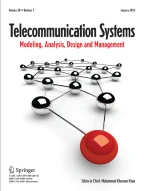Abstract
As increasing number of cognitive radio network (CRN) standards are developed in TV White Spaces band with incompatible communication patterns, heterogeneous CRNs coexistence problem could not be avoided. However, most solutions on this problem have not considered CRNs’ actual data transmission demands and weighted fairness simultaneously. Therefore, we would like to introduce a novel On-demand ecological Species Competition based HEterogeneous networks coexistence MEchanism (O-SCHEME) in this paper. Inspired by ecology species competition model, O-SCHEME utilizes an ecology based spectrum allocation mechanism for guaranteeing heterogeneous CRNs’ spectrum shares weighted fairness. And by employing CRNs’ communication spectrum requirement constraints, actual data transmission needs could be satisfied without wasted communication resources. Through both theoretical and simulation analyses, we demonstrate that O-SCHEME can achieve stable and fair spectrum allocations among coexisting networks with high communication efficiency.
Similar content being viewed by others
Explore related subjects
Discover the latest articles, news and stories from top researchers in related subjects.References
FCC Spectrum Policy Task Force, Report of the spectrum efficiency work group, Tech. Rep., November, 2002.
Mitola, J. (2009). Cognitive radio architecture evolution. Proceedings of the IEEE, 97(4), 626–641.
Mitola, J., & Maguire, G. Q. (1999). Cognitive radio: Making software radios more personal. IEEE Personal Communications, 6(4), 13–18.
Federal communications commission (fcc) 08-260: Second report and order and memorandum opinion and order in et docket nos. -2-380 (additional spectrum for unilicensed devices below 900 mhz and in the 3 ghz band) and 04-186 (unlicensed operation in the tv broadcast bands), Nov. 14, 2008.
IEEE 802.22 Working Group. http://www.ieee802.org/22/.
IEEE P802.11 task group af, Wireless LAN in the TV white space. http://www.ieee802.org/11/.
IEEE Std. (2010). IEEE 802.16 working group. IEEE standard for local and metropolitan area networks part 16: Air interface for broadband wireless access systems amendment 2: Improved coexistence mechanisms for licensed-exampt operation.
ECMA Std. (2009). ECMA TC48-TG1, Standard ECMA-392: MAC and PHY for operation in TV white space.
Wang, B., & Liu, K. (2011). Advances in cognitive radio networks: A survey. IEEE Journal of Selected Topics in Signal Processing, 5(1), 5–23.
Gao, B., Park, J.-M., Yang, Y., & Roy, S. (2012). A taxonomy of coexistence mechanisms for heterogeneous cognitive radio networks operating in tv white spaces. IEEE Wireless Communications, 19(4), 41–48.
IEEE 802.19 Task Group 1, Wireless Coexistence in the TV White Space. http://www.ieee802.org/19/pub/TG1.html.
Bian, K., Park, J. M. J., Du, X., & Li, X. (2013). Ecology-inspired coexistence of heterogeneous wireless networks. In Global communications conference (GLOBECOM), 2013 IEEE, pp. 4921–4926.
Bian, K., Park, J.-M., & Gao, B. (2014). Ecology-inspired coexistence of heterogeneous cognitive radio networks. In Cognitive radio networks (pp. 117–131). Berlin: Springer International Publishing.
Zhang, D., Liu, Q., Chen, L., & Xu, W. (2015).“Ecology-based coexistence mechanism in heterogeneous cognitive radio networks. In 2015 IEEE Global Communications Conference (GLOBECOM), Dec 2015, pp. 1–6.
Yin, Y., Zheng, M., & Zhang, Q. (2016). Heterogeneous coexistence between cognitive radio networks over tv white space: A nonlinear control perspective. In Transactions on Emerging Telecommunications Technologies, vol. 27, no. 11, pp. 1530–1538, ett.3094. [Online]. doi:10.1002/ett.3094
Zhao, Y., Song, M., Xin, C., & Wadhwa, M. (2012). Spectrum sensing based on three-state model to accomplish all-level fairness for co-existing multiple cognitive radio networks. In Proceedings IEEE INFOCOM, Orlando, FL, United states, pp. 1782–1790.
Zhao, Y., Song, M., & Xin, C. (2013). Fmac: A fair mac protocol for coexisting cognitive radio networks.” In Proceedings IEEE INFOCOM, Turin, Italy, pp. 1474–1482.
Sun, S., Chen, N., Ran, T., Xiao, J., & Tian, T. (2016). A stackelberg game spectrum sharing scheme in cognitive radio-based heterogeneous wireless sensor networks. Signal Processing, vol. 126, pp. 18 – 26, signal Processing for Heterogeneous Sensor Networks.
Amjad, M. F., Chatterjee, M., & Zou, C. C. (2016). Coexistence in heterogeneous spectrum through distributed correlated equilibrium in cognitive radio networks. Computer Networks, 98, 109–122.
Bian, K., Park, J. M., Chen, L., & Li, X. (2014). Addressing the hidden terminal problem for heterogeneous coexistence between TDM and CSMA networks in white space. IEEE Transactions on Vehicular Technology, 63(9), 4450–4463.
Zhang, H., Chu, X., Guo, W., & Wang, S. (2015). Coexistence of wi-fi and heterogeneous small cell networks sharing unlicensed spectrum. IEEE Communications Magazine, 53(3), 158–164.
Zhang, H., Jiang, C., Beaulieu, N. C., Chu, X., Wang, X., & Quek, T. Q. S. (2015). Resource allocation for cognitive small cell networks: A cooperative bargaining game theoretic approach. IEEE Transactions on Wireless Communications, 14(6), 3481–3493.
Yubo, Y., Panlong, Y., Xiangyang, L., Yue, T., Lan, Z., & Lizhao, Y. (2013). Zimo: Building cross-technology mimo to harmonize zigbee smog with wifi flash without intervention. In Proceedings of the 19th Annual International Conference on Mobile computing; Networking, ser. MobiCom’13. New York: ACM, pp. 465–476. [Online]. http://doi.acm.org/10.1145/2500423.2500426
Yang, P., Yan, Y., Li, X. Y., Zhang, Y., Tao, Y., & You, L. (2016). Taming cross-technology interference for wi-fi and zigbee coexistence networks. IEEE Transactions on Mobile Computing, 15(4), 1009–1021.
Liu, D., Zhang, H., Zheng, W., & Wen, X. (2012). The sub-channel allocation algorithm in femtocell networks based on ant colony optimization. In MILCOM 2012–2012 IEEE Military Communications Conference, Oct 2012, pp. 1–6.
Zhang, H., Jiang, C., Beaulieu, N. C., Chu, X., Wen, X., & Tao, M. (2014). Resource allocation in spectrum-sharing ofdma femtocells with heterogeneous services. IEEE Transactions on Communications, 62(7), 2366–2377.
Zhang, H., Chu, X., & Wen, X. (2016). 4G Femtocells: Resource Allocation and Interference Management. New York: Springer.
Murray, J. (2002). Mathematical biology I. An introduction (3rd ed.). Dordrecht: Kluwer.
Acknowledgements
This research is supported by National Natural Science Foundation of China (Grant Nos. 51675389 and 51475343), the International Science & Technology Cooperation Program, Hubei Technological Innovation Special Fund (Grant No. 2016AHB005), and the Fundamental Research Funds for the Central Universities (Grant No. 2017III5XZ).
Author information
Authors and Affiliations
Corresponding author
Rights and permissions
About this article
Cite this article
Zhang, D., Liu, Q., Chen, L. et al. On-demand ecology-inspired spectrum allocation mechanism for heterogeneous cognitive radio networks. Telecommun Syst 66, 589–601 (2017). https://doi.org/10.1007/s11235-017-0311-6
Published:
Issue Date:
DOI: https://doi.org/10.1007/s11235-017-0311-6
